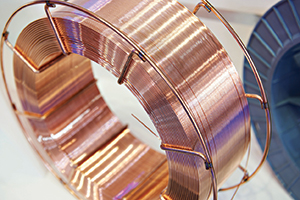
Posted to News on 24th Nov 2020, 00:00
Material considerations for spring applications
There are a number of factors to take into account in a spring’s application before going ahead with the design and manufacturing process, as Airedale Springs chairman, Tim Parkinson, explains.

A spring’s environment will hugely impact the materials chosen. It's crucial to consider the application environment because this will impact the final product – for example, if you need a spring for an electronic product, then that spring will probably need to be conductive and/or possess resistance to heat.
Load conditions: The load conditions represent a key consideration: can the spring withstand the stress conditions that it will be put under? The pressure or tension placed on a spring will impact its performance and lifespan, so it’s critical that the spring is made from a durable material capable of meeting these application loads. There are two different types of loads:
- With a static load, which refers to a fixed load that is applied in a gradual manner, the spring only needs to operate for a low number of cycles; its ability to withstand stress in these conditions will depend on the tensile strength of the material.
- A dynamic load consists of a force that is applied varyingly, and it means the spring itself is moving due to the pressure applied.
Materials like hard-drawn steel wire, which are more cost-effective, are suitable for applications where the load applied on the spring is static. Certain families of stainless steels, like the Duplex one, have high tensile strength, which means they can withstand a higher degree of pressure. They are also found in sectors like transportation (rail, cycling, etc). If the spring will be under a dynamic load, it also needs to have good resistance to fatigue – music wire is a good option for that.
Specific temperatures: When choosing materials, it’s also important to consider whether the spring will need to operate in an environment with low or high temperatures. If springs are used in environments with temperatures outside of their recommended levels, they can become damaged, deformed or brittle.
Chrome silicon alloys, for example, are a good option for sectors and applications where heat is a concern, since they can withstand high temperatures; in fact, their working temperatures are usually over 200°C. These alloys are also suitable for high-stress applications, since they have a high degree of fatigue resistance, like fuel injector springs. Low temperatures also require careful material consideration. Industries that work with low temperatures include the energy, agriculture and health sectors, and non-ferrous alloys, such as those containing nickel or the 300 series stainless steels, can perform well in both high and low temperatures.
Nearly all aluminium alloys can also be applied at temperatures around –45°C while still functioning well, and high-alloy austenitic stainless steels can work at temperature below –196°C.
Resistance to corrosion: Corrosive environments, like those found in chemical plants or in oil platforms at sea, require the use of materials that can not only withstand repeated use but that can also resist corrosion over time. While no spring – or any other part – will last forever, you have a better chance of maximising its longevity and of ensuring a good performance by selecting the right materials.
Corrosion happens when metal reacts to its surroundings, but some are less susceptible than others. Ideally, you should look for metals and alloys like:
- Cold-drawn copper alloys, which are excellent where good electrical conductivity is required and are also highly resistant to corrosion.
- Nickel alloys and chromium alloys, as they’re often resistant to corrosion in addition to being resistant to wear and tear and oxidation, making them suitable for a wide range of applications.
Hygienic and clinical environments: While this may not apply to everything, industries like the food and medical ones need to take hygiene into consideration. Not only do springs used in these sectors have to be durable and capable of handling high-pressure environments, but they also have to be easy to clean and disinfect, especially in today’s climate.
Stainless steels are suitable for these applications, as they help to keep places clean, reduce the risk of infection and help to save lives.
Magnetic properties: Certain environments require the use of magnetic or non-magnetic materials, so this is another property to consider. High carbon steel is a good example of a material that is widely popular, cost-effective and highly magnetic – however, the alloy has a low degree of resistance to corrosion and should be used in a sealed environment.
If the environment application requires a non-magnetic spring because of the surrounding materials (so nothing oscillate, for instance), then something like aluminium, titanium and bronze, just to name a few, are your best bet.
Weight restrictions: Industries like aerospace need springs and components that are strong, durable and long-lasting, as well as low in weight. In aircraft, every gram count, so materials like aluminium are often the preferred option.
This is because aluminium weighs only 2.7g/cm3, which is around a third of that of steel and allows for vehicles and aircraft to reduce dead-weight and improve energy consumption. A plane with many steel parts would never fly as well or operate as efficiently as one with aluminium components.
There are many material implications when it comes to different application environments, so choosing a spring manufacturer who understands this is vital. Airedale Springs has 75 years of knowledge and expertise, so we’re able to deliver high-quality springs and wire forms to clients in a large number of industries.
The Spring Works, Bridgehouse Lane
Haworth
BD22 8PA
UNITED KINGDOM
+44 (0)1535 643456








